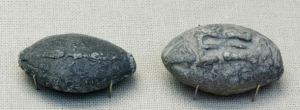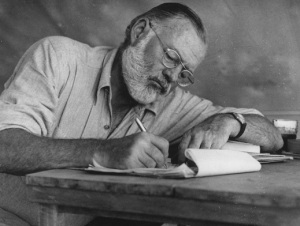 Ancient Greek sling bullets with engravings. One side depicts a winged thunderbolt, and the other, the Greek inscription “take that” in high relief.
Ancient Greek sling bullets with engravings. One side depicts a winged thunderbolt, and the other, the Greek inscription “take that” in high relief.
Ancient Origins has a great introductory article on slings.
I’ve long been fascinated by primitive weapons, and I think every fantasy author should know the basics of the ones he writes about. Not only does such knowledge add authenticity to the story, but helps the author get a feel for the artistry and discipline involved in mastering such a weapon. You don’t just pick up a sling and start hitting your target. The video below of a slinging competition will give you an idea of the deadliness of this elegant and simple weapon:
In my novella Aztec Midnight, the protagonist, Jon Barrett, learned how to use the sling from an elderly Mescalero Apache in Texas. Alone and defenseless in Cuernavaca, he must track down the drug cartel members who have kidnapped his wife. Barrett constructs a sling on the run, and approaches the cartel’s hideout. It’s night, and he can hear a guard treading back and forth on the dark front porch. How can Barrett take the guard down without alerting the others inside?
Precious minutes slipped by. Nothing stirred. In the distance, another train approached Cuernavaca station. Its whistle barely rose above the subdued rumble.
A ghostly silhouette appeared at the end of the porch. I realized the guard had moved in front of a shaded window. Its glow barely formed an outline. I had to take my chance. After placing the roundest rock in the pouch, I stepped forward and swung the sling. The release felt perfect.
The outlined figure did not react. Then the speeding rock tore into bushes and trees on the other side of the yard, and the guard jerked his head toward the sound.
This was my last chance. I took another step forward, slipped a rock into the pouch, swung as smoothly as I could, and released the string.
That passage still makes my blood pump.
Okay, I’ve worked at the computer long enough. Time to change, grab my sling kit, and jog down to the park for some target practice.






